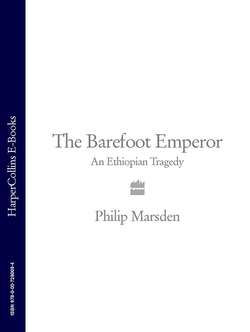Читать книгу The Barefoot Emperor: An Ethiopian Tragedy - Philip Marsden - Страница 14
Оглавление3
Ethiopia’s Christians suffered not only from the endless round of civil war, but from the collective grief of former glory. In their eyes, Ras Ali was a usurper. He was an Oromo, and the Oromo did not share the same blessings as themselves, the high destiny bestowed on them, centuries earlier, by God. The Oromo were a pastoralist people, mainly Muslim, who had pushed up into the central highlands in the eighteenth century. They proved fearless in battle and were used as warriors first by the emperors’ rivals against the emperor, then by the emperor himself against his rivals. As the Christian regime weakened, the Oromo grew more powerful. In 1803, Ras Gugsa – grandfather of Ras Ali – became the country’s ruler, and converted from Islam to the Christianity of most of his subjects (though they all knew that really a hyena cannot become a goat).
Ras Gugsa ruled for twenty-two years, and according to Zeneb, the Christian chronicler, those men who refused to submit to him had their penises cut off, while women lost their breasts.
In the 1830s, at the age of twelve, Ras Ali became head of the dynasty. During his regency his mother Menen ruled in his stead. Reports describe her variously as capricious, flirtatious, wanton and shameless. She governed from the half-ruined palaces of the city of Gondar. In their rough stone interiors she listened unseen to the affairs of the court, sending judgements and orders through her eunuchs. Outside stood crowds of farmers and soldiers, noblemen and shield-bearers, priests and beggars: ‘suppliants’, wrote Plowden, ‘who cannot obtain admittance, loudly crying their tale of woe … and perchance some man, once great – whose eyes have been extinguished by the order of her at whose door he is now sitting’.
The traditional rulers of Ethiopia, from the line that had embraced Christianity in the year AD330 but who traced their origins back to the union of King Solomon and the Queen of Sheba, had been in decline for years. King-makers and regional rulers plucked princes from the mountaintop prisons where they were kept from birth. They rarely lasted long on the throne. Soon Gondar was full of toppled emperors, living in penury. Many were crowned and ousted and crowned again – Tekle Giyorgis was enthroned six times. Menen herself took one in 1840 and placed him on the throne as King of Kings Yohannis III. He was sixteen at the time, and she married him in order to become itege or empress. He was on and off the throne for years, and grew into a drinker and rarely left his harem. He became known as Yohannis the Fool.
The people of the highlands, the Christian farmers whose land and stores were forever being plundered by shifting hordes of rebels and regional armies, sought solace in the traditions of their faith. The priests reminded them that from the death of Joshua until the rise of King David, the children of Israel suffered a period known as the Zemene Mesafint, the Time of Judges, and because there is nothing that happens that has not already happened in the Old Testament, the Christians of Ethiopia realised that they too were living in the Zemene Mesafint. Their trials were a punishment for their sins: ‘The children of Israel did evil in the sight of the Lord and served Baalim … And the anger of the Lord was hot against Israel, and he delivered them into the hands of spoilers who spoiled them, and he sold them into the hands of their enemies.’
The Ethiopian chronicles gave voice to the humiliation felt in the heart of every Christian highlander: ‘How is it that the kingdom is a laughing stock to the uncircumcised from the very beginning? How is it that the kingdom is the image of a worthless flower that children pluck in the autumn rains?’
Yet just as God had sent the Mesafint to punish his errant children, so one day he would end it. It had long been prophesied that in Ethiopia a great ruler would rise and restore the glory of the Christian kingdom. The longer the Mesafint went on, the more people remembered the words of the Fekkare Iyesus, stating clearly that a ruler would emerge to resurrect Ethiopia, banish her enemies and herald an era of peace, and that this ruler would be called Tewodros. In the 1830s a whisper began to be heard in the highlands. It reached the shores of Lake Tana, the villages of Begemder, and the stony streets of Gondar. He is come! Tewodros is come!
Outside a convent on the banks of the River Qaha, the saviour himself raised a horn to his lips:
‘I am the king whose name is Tewodros!’
In Gondar, the puppet emperor Sahle Dengel, ruling for the first of his four reigns, heard like Herod of the coming of the new king. He rose and sought him out. Within days, haloed by flies, the severed head of this Tewodros was hanging in the main square of Gondar.
Ras Ali and Menen remained in power. The wars raged on. The Zemene Mesafint continued.
